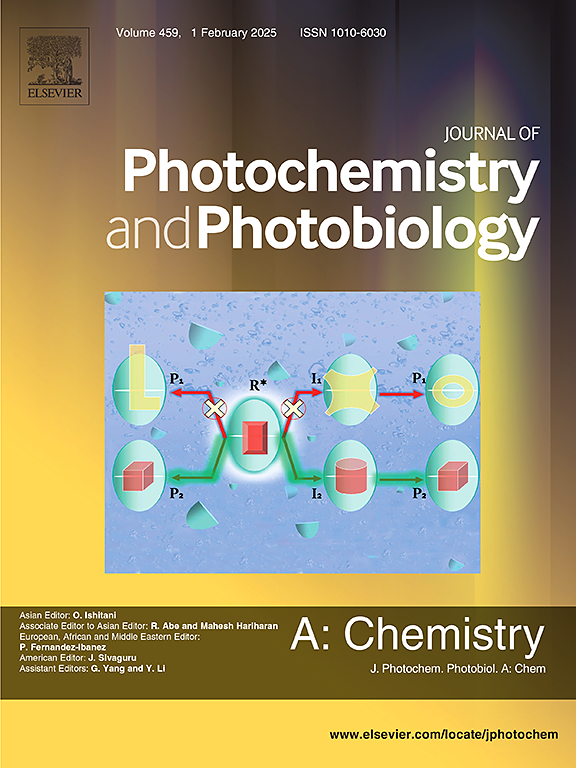Isotope tracing study to directly reveal the roles of H2O’s oxygen and hydrogen atoms in photocatalytic oxidation of gaseous aromatic alcohols to aromatic products
IF 4.1
3区 化学
Q2 CHEMISTRY, PHYSICAL
Journal of Photochemistry and Photobiology A-chemistry
Pub Date : 2025-04-24
DOI:10.1016/j.jphotochem.2025.116447
引用次数: 0
Abstract
H2O shows a significant contribution to form oxygen- and hydrogen-containing products during photocatalytic oxidation of aromatic hydrocarbons. However, it was unclear what the roles of atoms in H2O in subsequent oxidation of these products. In this study, the photocatalytic oxidation of two aromatic alcohols, benzyl alcohol and phenethyl alcohol, on TiO2 (79 % anatase and 21 % rutile) were investigated in mixed H2O (or H218O, D2O) and O2 system. Aromatic aldehydes, acids and esters were main aromatic products, while modified TiO2 and isotope-containing H2O did not change the product species. Aromatic aldehydes showed ≤ 0.19 % and ≤ 1.58 % of 18O- and D-labeling rates, suggesting hardly involvement of H2O in their formation. Aromatic acids exhibited a 18O-labeling rate range of 28.12 %-40.33 % and the highest D-labeling rate of 0.76 %, while a maximum enhancement of 18O-labeling rate was 0.11 % in the –C=O group of the acids, indicating that H2O selectively provided O atom in the formation of –OH group of aromatic acids. The 18O- and D-labeling rates of aromatic esters were in the range of 9.01 % to 15.95 % and 1.73 % to 8.08 %, suggesting that both oxygen and hydrogen atoms from H2O contributed to aromatic ester formation. Further analyzing mass fragmentation confirmed that H2O separately contributed its hydrogen and oxygen atoms to the –C=O and R–O groups of the esters. Based on the isotope tracing results, the contribution roles of H2O’s hydrogen and oxygen atoms in oxidation of aromatic alcohols to corresponding aromatic products were proposed. The findings in this study help to clarify the role of H2O in the oxidation process of aromatic alcohols at the atomic level and comprehensively reveal the oxidation mechanism of the aromatics.

同位素示踪研究,直接揭示H2O的氧原子和氢原子在气态芳香族醇光催化氧化生成芳香族产物中的作用
在光催化氧化芳烃过程中,H2O对含氧和含氢产物的形成有重要贡献。然而,在这些产物随后的氧化过程中,H2O原子的作用尚不清楚。在H2O(或H218O、D2O)和O2混合体系中,研究了两种芳香醇(苯甲醇和苯乙醇)在TiO2(79%锐钛矿和21%金红石)上的光催化氧化反应。芳香产物主要为芳香醛类、酸类和酯类,改性TiO2和含同位素H2O对产物种类没有影响。芳香醛的18O-标记率≤0.19%,d -标记率≤1.58%,表明水几乎不参与其形成。芳香酸的180 - O标记率范围为28.12% ~ 40.33%,d -标记率最高为0.76%,而酸的-C =O基团的180 - O标记率的最大增强为0.11%,说明在芳香酸-OH基团的形成过程中,H2O选择性地提供了O原子。芳香族酯的18O-标记率为9.01% ~ 15.95%,d -标记率为1.73% ~ 8.08%,表明H2O中的氧原子和氢原子都参与了芳香族酯的形成。进一步的质量碎片分析证实H2O分别将其氢原子和氧原子贡献给酯的-C =O和R-O基团。根据同位素示踪结果,提出了H2O的氢原子和氧原子在芳香醇氧化生成相应芳香产物中的贡献作用。本研究结果有助于在原子水平上阐明H2O在芳香醇氧化过程中的作用,全面揭示芳香醇氧化机理。
本文章由计算机程序翻译,如有差异,请以英文原文为准。
求助全文
约1分钟内获得全文
求助全文
来源期刊
CiteScore
7.90
自引率
7.00%
发文量
580
审稿时长
48 days
期刊介绍:
JPPA publishes the results of fundamental studies on all aspects of chemical phenomena induced by interactions between light and molecules/matter of all kinds.
All systems capable of being described at the molecular or integrated multimolecular level are appropriate for the journal. This includes all molecular chemical species as well as biomolecular, supramolecular, polymer and other macromolecular systems, as well as solid state photochemistry. In addition, the journal publishes studies of semiconductor and other photoactive organic and inorganic materials, photocatalysis (organic, inorganic, supramolecular and superconductor).
The scope includes condensed and gas phase photochemistry, as well as synchrotron radiation chemistry. A broad range of processes and techniques in photochemistry are covered such as light induced energy, electron and proton transfer; nonlinear photochemical behavior; mechanistic investigation of photochemical reactions and identification of the products of photochemical reactions; quantum yield determinations and measurements of rate constants for primary and secondary photochemical processes; steady-state and time-resolved emission, ultrafast spectroscopic methods, single molecule spectroscopy, time resolved X-ray diffraction, luminescence microscopy, and scattering spectroscopy applied to photochemistry. Papers in emerging and applied areas such as luminescent sensors, electroluminescence, solar energy conversion, atmospheric photochemistry, environmental remediation, and related photocatalytic chemistry are also welcome.

 求助内容:
求助内容: 应助结果提醒方式:
应助结果提醒方式:


